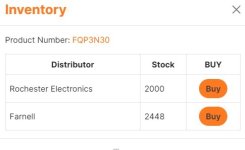considering arrangement in which they're used, how much difference you're expecting?
and, could it (difference) be of same quantity as in SUSY stages?
and, could it (difference) be of same quantity as in SUSY stages?
That is the question, which stem from people noticing an improvement and in favor for the J313/K2013 over say Vishay IRF610/9610. So naturally I have to check if the same difference exist between the J313/K2013 and FQP3N30/FQP3P20.
I know the J313/K2013 or FQP3N30/FQP3P20 has been the go to advice in the diya community and by N.Pass for many years now - but both are EOL since long. I can still get quite a lot of FQP parts and since I intend to build this headphone amp, ordering those parts and also doing so for other SuSy stages could be financially wise.
The J313/K2013 are a HEAVY financial "burden"... LOL
I know the J313/K2013 or FQP3N30/FQP3P20 has been the go to advice in the diya community and by N.Pass for many years now - but both are EOL since long. I can still get quite a lot of FQP parts and since I intend to build this headphone amp, ordering those parts and also doing so for other SuSy stages could be financially wise.
The J313/K2013 are a HEAVY financial "burden"... LOL
you asked a question, then I asked mine, intending to help you in differentiating important things - where and in which context parts type is making much difference, and where is not
now, taking in account final value of (any) construction containing those small mosfets, price difference between plain vanilla ones and (say) 313/2013 is no big deal
now, taking in account final value of (any) construction containing those small mosfets, price difference between plain vanilla ones and (say) 313/2013 is no big deal
Alright. In a SuSy gain stage, those MOSFETs are the final stage and final active part contributing to sound.
Lets then look at something specific. Reverse Transfer Capacitance:
P-Chn: J313 = 45pF while 3P20 = 7,5pF
N-Chn: K2013 =17pF while 3N30 = 6pF
Why I mention this is because Crss is equivalent to Cg-a (gate to anode capacitance of triodes) and lower is generally better since less signal energy is used to charge the capacitive value and ergo, more signal can be transferred directly.
So if this value where of importance, then the FQP is a better component over the 2SJ/2SK's
Lets then look at something specific. Reverse Transfer Capacitance:
P-Chn: J313 = 45pF while 3P20 = 7,5pF
N-Chn: K2013 =17pF while 3N30 = 6pF
Why I mention this is because Crss is equivalent to Cg-a (gate to anode capacitance of triodes) and lower is generally better since less signal energy is used to charge the capacitive value and ergo, more signal can be transferred directly.
So if this value where of importance, then the FQP is a better component over the 2SJ/2SK's
So if this value where of importance,
just one way to find out what is of greatest importance and when - to start building .....
though, I certainly had my time when obsessing was much more interesting than building ..... I could obsess with no end, free of any responsibility to actually draw conclusions
At the end of the day, if both parts can be used, is officially recommended and does not offer a discernible difference in performance / sound, the one that gets you there financially faster, makes more sense. And quantity... quantity to get many matched pairs for future projects - That was what I was concerned about.
And, I have, to my knowledge, not heard the Toshiba nor Fairchild's for that matter, so either way, I have no reference for what I lose/gain going over one over the other.
And, I have, to my knowledge, not heard the Toshiba nor Fairchild's for that matter, so either way, I have no reference for what I lose/gain going over one over the other.
Not sure how important this is, but I noticed that the measured Vgs(th)-voltage for my FQ's is higher than for e.g. IRF610s and therefore much higher than for the 2SK/2SJs. Based on what I have previously seen for e.g. the BA3FE-design, this might be worth looking into in case it requires other parts being adjusted if you don't use the FQs.
Gate turn on is 4V for FQP and 2V for 2SK/2SJ - this is mentioned in Pa's BA-3 document

IRF part is 2-4V so is closer to FQP than 2SK/2SJ
IRF part is 2-4V so is closer to FQP than 2SK/2SJ
That is because the HPA-1 does not use Toshiba parts but the Fairchild. One could translate that to "either works" within the PASS family of products... 😆
Please see the earlier comments from Jam regarding sonic differences between Toshiba vs Fairchild mosfets in the HPA-1 circuit (post #293):
https://www.diyaudio.com/community/threads/pass-hpa-1-what-do-we-know.300060/page-15#post-6712008
https://www.diyaudio.com/community/threads/pass-hpa-1-what-do-we-know.300060/page-15#post-6712008
Who can help ?
I need 2 pieces of Mosfets FQP3P20 and FQP3N30, which I can't get in Spain.
Thanks Michael.
I need 2 pieces of Mosfets FQP3P20 and FQP3N30, which I can't get in Spain.
Thanks Michael.
@michaelbehrendt I can actually help you with that. I am going to put in an order myself for the FQP parts as well as the KSA992/KSC1845 - PM me and I will provide you with some information 🙂
https://www.onsemi.com/products/discrete-power-modules/mosfets/FQP3P20Who can help ?
I need 2 pieces of Mosfets FQP3P20 and FQP3N30, which I can't get in Spain.
Thanks Michael.
https://www.onsemi.com/products/discrete-power-modules/mosfets/FQP3N30
Buy as samples from ONSEMI.
- Home
- Amplifiers
- Pass Labs
- Pass HPA-1, what do we know?




